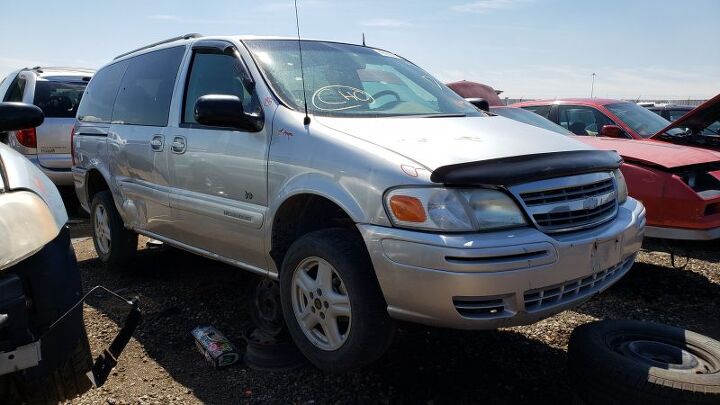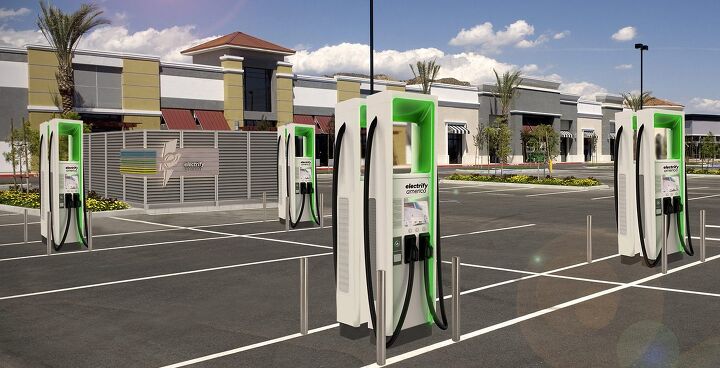#BusinessPartnerships
What's in Your Wallet? If Ford Has Its Way, It'll Be a Blue Oval
Ford has teamed up with the payment company Stripe in a five-year deal to leverage what they’re calling “automotive e-commerce and payments”. According to marketers in the Glass House, this arrangement will help facilitate transactions for vehicle services and products such as EV charging.
And if you think it couldn’t lead to subscription services for features we currently take for granted in vehicles today, we have some seaside property in Montana to sell you.
Junkyard Find: 2002 Chevrolet Venture Warner Brothers Edition
Back in the days before smartphones and cheap tablet computers, parents planning to take some screaming ankle-biters on a long road trip needed some means of hypnotizing the little darlings into submission, something that didn’t involve extreme measures such as tranquilizer dart guns or child literacy. Minivan makers began installing airliner-style flip-down video displays in the 1990s, enabling The Slime to ooze out of tiny flat screens on the road. The General took this idea one step further, partnering with Warner Brothers to issue a special-edition Chevy Venture packed with Looney Tunes goodies and branding. I spent years trying to find one of these rare vans in the U-Wrench-It yards I frequent, and I hit pay dirt last month in Denver.
VW's Electrify America Sticks With Walmart for EV Charging Expansion
Roughly a year ago, Volkswagen subsidiary Electrify America announced a partnership with Walmart to help proliferate EV charging sites across the United States. Equal parts penance for VW’s illegal diesel shenanigans and shrewd business arrangement, the deal sought to establish plug-in points at 100 store locations in 34 states.
On Thursday, the companies announced the completion of 120 charging stations and signalled their intent to continue collaborating — citing future development programs in the District of Columbia and 46 U.S. states.
How Are Autonomous Vehicles Supposed to Make Automakers Money?
As we continue reporting on how costly mobility projects, connectivity, and autonomous development are weighing on automakers’ bottom line, readers want to know exactly when these endeavors will become profitable. While the path for data acquisition and in-car marketing is fairly clear, self-driving cars are new territory. But it’s all speculative. Logistical, ethical and regulatory issues abound — and legislators seem rather poorly informed on the technology in general.
For now, companies have a pass to test autonomous vehicles in limited quantities across the United States. The next move, which some firms (like Waymo) have already undertaken, involves adapting test-bed AVs for use in commercial fleets. Profitability is another matter, and concerns are mounting that the technology isn’t ready and might not be for some time.
Auto Coalition Joins Forces With NATCO to Rethink City Streets, Share Driving Data
The National Association of City Transportation Officials (NATCO) has joined Ford, Uber and Lyft to work with the data platform SharedStreets to glean a better understanding of America’s infrastructure. Their collective goal is to “make it easier for the private sector to work with cities around the world and leverage data to improve urban mobility.”
That means different things to different companies. For Uber and Lyft, aggregate data on passenger pickups and drop-offs could be useful in deciding where to deploy their vehicles. The information could also prove helpful in telling city planners how to best manage traffic patterns. Uber also said it would track speeders and what on types of roads people are more apt to drive dangerously.
VW to Continue 'Electrifying America' With Help From Walmart
Volkswagen’s ongoing penance for its diesel-emission scandal includes a serious investment in to the United States’ EV charging infrastructure. But critics of the plan have previously suggested it might be a way for VW to capitalize on its corporate wrongdoing. The state of California wanted the German company to focus on disadvantaged communities while automakers worried VW might gain an early advantage in a competitive new market, especially if it could handpick the sites or partner with businesses.
It has been almost 10 months since those concerns were voiced and now Electrify America (a subsidiary of Volkswagen Group) has announced it will be partnering with Walmart to install electric charging stations at 100 stores in 34 states across America. That way you can help save the environment while you’re stocking up on plastic cups and single-serve coffee pods that will end up being dumped into the ocean.
Mazda and Toyota Take Their Relationship to the Next Level, Start Planning an Assembly Plant
Toyota Motor Corp. is set to strike a deal to take a 5-percent stake in fellow Japanese automaker Mazda Motor Corp. The alliance includes the construction of a joint-venture $1.6 billion U.S. automotive plant and sharing EV technology — showing that Mazda hasn’t totally sworn off the idea of an electric car.
The two companies have been dating casually for a couple of years; Toyota sometimes uses Mazda’s Mexican factory to build compact cars, the two have fostered a love child (the Mazda 2-based Toyota Yaris iA), but this is the first time they’ve seriously considered moving in together. Toyota claimed the decision was about more than just a strategy to share technology, suggesting the automakers had genuine feelings for one another.
“The greatest fruit of our partnership with Mazda is that we have found a new partner who truly loves cars,” Toyota President Akio Toyoda said in a statement, “It has also sparked Toyota’s competitive spirit, increasing our sense of not wanting to be bested by Mazda. This is a partnership in which those who are passionate about cars will work together to make ever-better cars. It is also the realization of our desire to never let cars become commodities.”
60-year-old Cars Are Great, but Caterham Desperately Wants Something New
Postwar British nostalgia and racing heritage is nice, but there’s no denying the kick an automaker can get from launching a wholly new vehicle.
That’s the situation Caterham finds itself in. After dutifully cranking out continuously updated examples of the original Lotus Seven since 1973, the company now wants to court drivers who have never seen the opening titles of The Prisoner. While the British company has a pretty good idea of the car it wants to build, it first needs to find a partner.
Toyota and Suzuki, Scared of Falling Behind, Eye Partnership
This could be the start of a beautiful business partnership.
After its romance with Volkswagen AG ended in a bitter breakup last year, Suzuki is considering hopping into bed with the world’s largest automaker.
Toyota and Suzuki issued a joint press release today announcing their intention to get together and see where it goes.
























Recent Comments